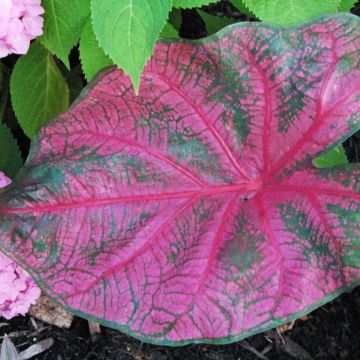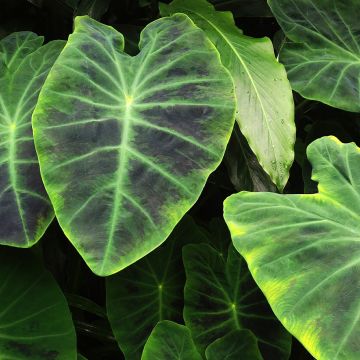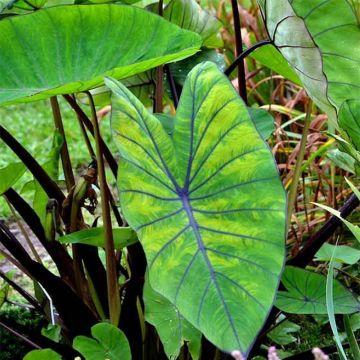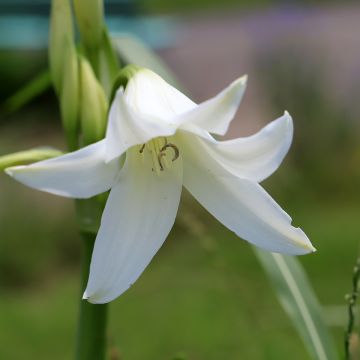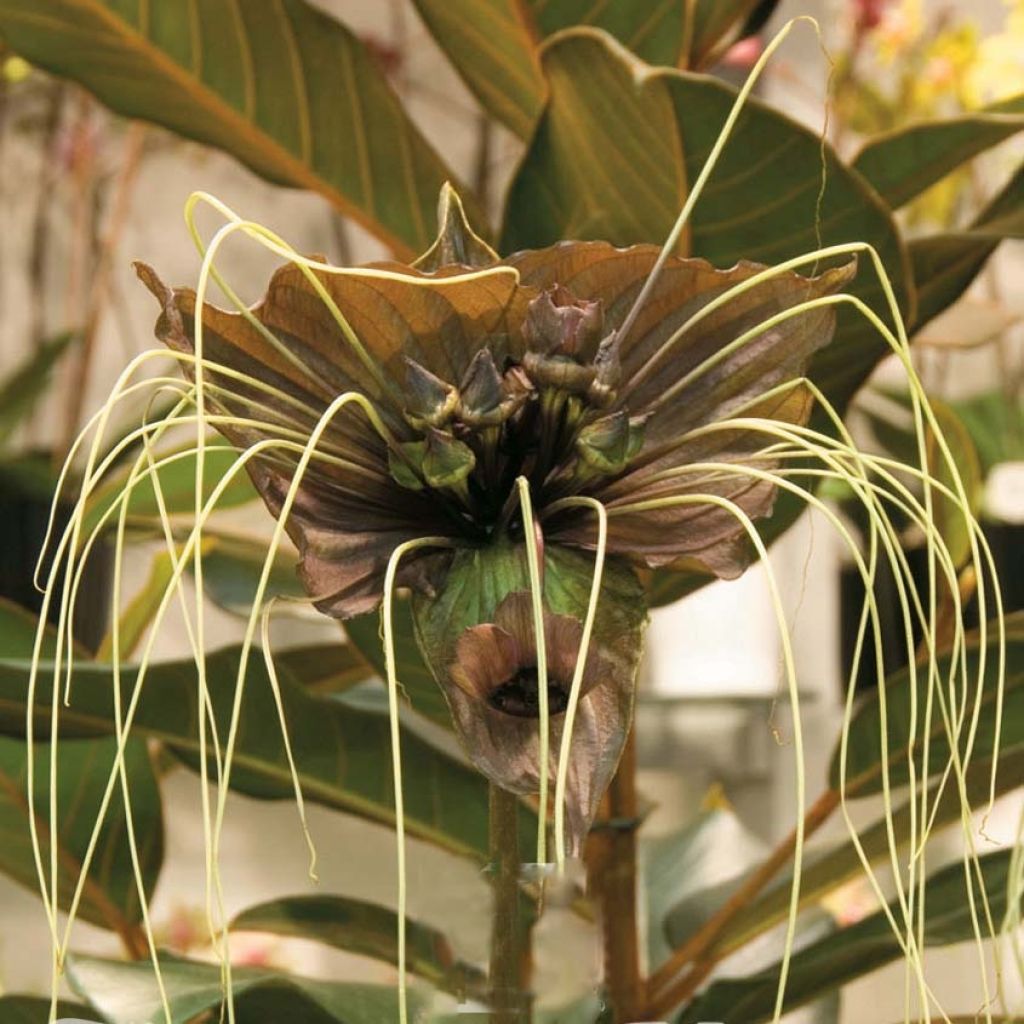

Tacca chantrieri Green Isle
Tacca chantrieri Green Isle
Tacca chantrieri Green Isle
Black Bat Flower, Bat Head Lily
This item cannot be shipped to the selected country
Delivery charge from €5.90
More information
Schedule delivery date,
and select date in basket
This plant carries a 6 months recovery warranty
More information
We guarantee the quality of our plants for a full growing cycle, and will replace at our expense any plant that fails to recover under normal climatic and planting conditions.
From €5.90 for pickup delivery and €6.90 for home delivery
Express home delivery from €8.90.
Does this plant fit my garden?
Set up your Plantfit profile →
Description
Tacca chantrieri 'Green Isle' is a rare form of this strange bulbous plant commonly known as the Bat Plant or Bat Flower, in shades of green and light brown. It unfurls its large bracts like wings around a cluster of dark flowers, accompanied by long green filaments trailing in graceful fringe. This inflorescence is borne on a stem emerging from a basal tuft of elongated, elegant, shiny green leaves. Native to tropical regions of Asia, this frost-tender plant is best suited for experienced or curious gardeners, and should be grown in a warm, humid greenhouse in a bright location, but without direct sunlight.
Tacca chantrieri belongs to the family Taccaceae, consisting of the only genus Tacca. It is a perennial rhizomatous species native to Thailand, Myanmar (Burma), and nearby regions of China, naturalized and cultivated in many tropical Asian regions. In the wild, it is found growing in forests, valleys, along rivers, from 200m (656ft) up to 1300m (4265ft) altitude, on acidic and humus-rich soil. Under good growing conditions, it reaches a height of 75 to 90cm (30 to 35in) when flowering, 40 to 50cm (16 to 20in) for the foliage. The 'Green Isle' variety is a form with unusual colours blending green and light brown.
The plant develops from thick rhizomes. It forms a clump of basal leaves, borne on petioles 10 to 30cm (4 to 12in) long, with oblong and entire lamina measuring 20 to 50cm (8 to 20in) (sometimes 60cm (24in)) in length and 7cm (3in) in width. The leaves resemble those of spathiphyllums. They are glabrous or pubescent, cuneiform, pointed at their tips. The foliage is bright green and shiny, with visible veins. In our climates, flowering occurs from June to August, and sporadically until December. Only plants aged 2 or 3 years produce inflorescences. This "bat flower" gets its name from its very distinctive inflorescence, which resembles the small mammal. The flowers are brown, fairly light, composed of 5 petals, clustered in bouquets (up to 25 flowers) at the centre of four bracts, two of which, in outer position, are particularly developed. They are tinted green and veined with light brown, turning brown. Each flower pedicel produces long trailing green filaments, 25cm (10in) long, forming a shooting star tail. The fruits are berries containing numerous small kidney-shaped seeds.
The 'Green Isle' bat flower is a plant for experienced gardeners, a curiosity to be admired up close, protected from cold and scorching sun, in a heated greenhouse or conservatory, without direct sunlight. It adorns itself with beautiful foliage and offers one of the most interesting flowers found in plants. As such, it can only provoke fascination and interest in those who contemplate it. However, it can sometimes be temperamental and demanding in terms of growing conditions. When it is happy, this plant grows, flowers abundantly, and even produces offshoots. When something is lacking, it slowly weakens and eventually disappears. Unfortunately, the only way to know if you can provide it with good growing conditions is to give it a try. Keep in mind that this plant originates from the hot and humid tropical areas of Asia and experiences some dryness during its rest period in winter in our latitudes.
Report an error about the product description
Tacca chantrieri Green Isle in pictures
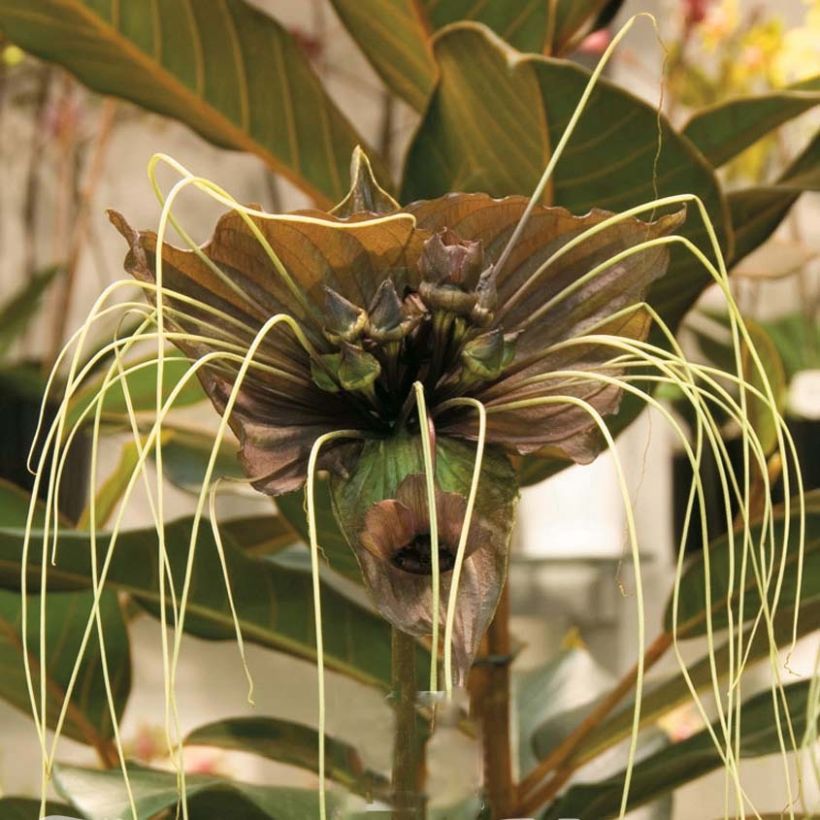

Plant habit
Flowering
Foliage
Botanical data
Tacca
chantrieri
Green Isle
Taccaceae
Black Bat Flower, Bat Head Lily
Southeast Asia
Other Tacca - Bat plant
Planting and care
The best time to plant Tacca chantrieri 'Green Isle' is late winter, in March. Place the rootstock in a 20cm (8in) diameter pot, perforated at the bottom, in a very well-draining, slightly acidic mixture, preferably based on peat, perlite and peat-rich potting soil with fibrous bark. A mixture composed of one-third leaf soil, one-third crushed pine bark and one-third coconut fibres will be perfect. The quality of the substrate is a determining factor for successfully growing this strange plant. During the growing season (from spring to the end of summer), the plants will need to be regularly watered with non-calcareous rainwater at room temperature. The substrate must be well-drained and regularly enriched with a fertilizer for peaty soil plants, as it is nutrient-poor. Ideally repot every year, or every 2 years. Frequently mist the foliage with rainwater to maintain a good level of humidity and thus prevent the development of red spider mites, which thrive in dry and warm atmospheres. Give very little water in winter and no fertilizer to respect a dormancy period of approximately 2 months and keep the plant at a temperature of 15-18°C (59-64.4°F) (the plant can perish at 12°C (53.6°F)) in winter. Maintain a temperature of 25-29°C (77-84.2°F) during summer.
These plants require peaty but not waterlogged soil, bright shade, and a humid and mild atmosphere, just like some orchids.
To understand the optimal growing conditions for the Bat Flower, it may be useful to know the climate of its country of origin:
Myanmar, its country of origin, has three seasons. A temperate season from October to February with an average temperature range of 20 to 24 degrees (68 to 75.2°F), a hot season from March to May with temperatures ranging from 30 to 35 degrees (86 to 95°F), and finally a rainy season from June to September with temperatures ranging between 25 and 30 degrees (77 and 86°F).
Planting period
Intended location
Care
This item has not been reviewed yet - be the first to leave a review about it.
Bulbs for the home
Haven't found what you were looking for?
Hardiness is the lowest winter temperature a plant can endure without suffering serious damage or even dying. However, hardiness is affected by location (a sheltered area, such as a patio), protection (winter cover) and soil type (hardiness is improved by well-drained soil).

Photo Sharing Terms & Conditions
In order to encourage gardeners to interact and share their experiences, Promesse de fleurs offers various media enabling content to be uploaded onto its Site - in particular via the ‘Photo sharing’ module.
The User agrees to refrain from:
- Posting any content that is illegal, prejudicial, insulting, racist, inciteful to hatred, revisionist, contrary to public decency, that infringes on privacy or on the privacy rights of third parties, in particular the publicity rights of persons and goods, intellectual property rights, or the right to privacy.
- Submitting content on behalf of a third party;
- Impersonate the identity of a third party and/or publish any personal information about a third party;
In general, the User undertakes to refrain from any unethical behaviour.
All Content (in particular text, comments, files, images, photos, videos, creative works, etc.), which may be subject to property or intellectual property rights, image or other private rights, shall remain the property of the User, subject to the limited rights granted by the terms of the licence granted by Promesse de fleurs as stated below. Users are at liberty to publish or not to publish such Content on the Site, notably via the ‘Photo Sharing’ facility, and accept that this Content shall be made public and freely accessible, notably on the Internet.
Users further acknowledge, undertake to have ,and guarantee that they hold all necessary rights and permissions to publish such material on the Site, in particular with regard to the legislation in force pertaining to any privacy, property, intellectual property, image, or contractual rights, or rights of any other nature. By publishing such Content on the Site, Users acknowledge accepting full liability as publishers of the Content within the meaning of the law, and grant Promesse de fleurs, free of charge, an inclusive, worldwide licence for the said Content for the entire duration of its publication, including all reproduction, representation, up/downloading, displaying, performing, transmission, and storage rights.
Users also grant permission for their name to be linked to the Content and accept that this link may not always be made available.
By engaging in posting material, Users consent to their Content becoming automatically accessible on the Internet, in particular on other sites and/or blogs and/or web pages of the Promesse de fleurs site, including in particular social pages and the Promesse de fleurs catalogue.
Users may secure the removal of entrusted content free of charge by issuing a simple request via our contact form.
The flowering period indicated on our website applies to countries and regions located in USDA zone 8 (France, the United Kingdom, Ireland, the Netherlands, etc.)
It will vary according to where you live:
- In zones 9 to 10 (Italy, Spain, Greece, etc.), flowering will occur about 2 to 4 weeks earlier.
- In zones 6 to 7 (Germany, Poland, Slovenia, and lower mountainous regions), flowering will be delayed by 2 to 3 weeks.
- In zone 5 (Central Europe, Scandinavia), blooming will be delayed by 3 to 5 weeks.
In temperate climates, pruning of spring-flowering shrubs (forsythia, spireas, etc.) should be done just after flowering.
Pruning of summer-flowering shrubs (Indian Lilac, Perovskia, etc.) can be done in winter or spring.
In cold regions as well as with frost-sensitive plants, avoid pruning too early when severe frosts may still occur.
The planting period indicated on our website applies to countries and regions located in USDA zone 8 (France, United Kingdom, Ireland, Netherlands).
It will vary according to where you live:
- In Mediterranean zones (Marseille, Madrid, Milan, etc.), autumn and winter are the best planting periods.
- In continental zones (Strasbourg, Munich, Vienna, etc.), delay planting by 2 to 3 weeks in spring and bring it forward by 2 to 4 weeks in autumn.
- In mountainous regions (the Alps, Pyrenees, Carpathians, etc.), it is best to plant in late spring (May-June) or late summer (August-September).
The harvesting period indicated on our website applies to countries and regions in USDA zone 8 (France, England, Ireland, the Netherlands).
In colder areas (Scandinavia, Poland, Austria...) fruit and vegetable harvests are likely to be delayed by 3-4 weeks.
In warmer areas (Italy, Spain, Greece, etc.), harvesting will probably take place earlier, depending on weather conditions.
The sowing periods indicated on our website apply to countries and regions within USDA Zone 8 (France, UK, Ireland, Netherlands).
In colder areas (Scandinavia, Poland, Austria...), delay any outdoor sowing by 3-4 weeks, or sow under glass.
In warmer climes (Italy, Spain, Greece, etc.), bring outdoor sowing forward by a few weeks.








































